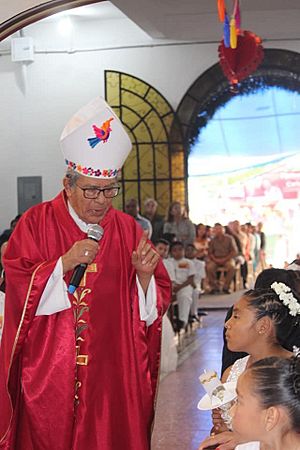Arturo Lona Reyes facts for kids
Arturo Lona Reyes (born November 1, 1925 – died October 31, 2020) was a Catholic bishop from Tehuantepec, Oaxaca, Mexico. He served as a bishop for 30 years. He stepped down from his role in 2001.
A Life of Service
Arturo Lona Reyes was born on November 1, 1925, in Aguascalientes, Mexico. He became a Roman Catholic priest in 1952. He was known for his simple style, often wearing a white shirt, blue jeans, and traditional Mexican sandals called huaraches. He also wore a large wooden cross around his neck.
In 1971, Lona Reyes joined the church in Tehuantepec. He had strong beliefs about helping people and making society fairer. His ideas were inspired by the Second Vatican Council, a big meeting of Catholic leaders in the 1960s. He wanted the church to be a "popular church," meaning it should actively help the poor and work for social justice.
In 1972, he led a special group focused on indigenous people. To help local farmers, he started two farming groups. One group sold organic coffee to countries in Europe. The other group sold sesame seeds. The money earned was shared equally among all the members. He was also famous for giving advice to indigenous communities. He helped them when they faced big companies wanting to build mines, wind farms, or cut down trees on their land.
On June 29, 1995, Lona Reyes was attacked by gunmen. People believed he was targeted because he was the head of the Tepeyac Human Rights Centre. This center worked to protect people's rights in Tehuantepec. Throughout his life, he was physically attacked 11 times because of his work.
Stepping Down as Bishop
In 1998, Lona Reyes was asked to resign from his position. For several years, some people had accused him of being involved with political groups and causing trouble. They said he supported groups that the government did not like. These accusations came from his support for the Coalition of Workers, Peasants, and Students of the Isthmus (COCEI). The government thought his support helped this group grow quickly. For example, in May 1979, Lona Reyes helped families whose relatives from COCEI had been taken prisoner. The government did not approve of this. Because of his close relationship with COCEI, the government even closed churches and sent away some church workers. However, the government never showed clear proof that Lona Reyes was directly involved in any illegal actions by COCEI.
Lona Reyes said he was being asked to resign because he supported something called liberation theology. This idea teaches that spiritual freedom is connected to economic and political freedom. He believed that helping people gain freedom in their daily lives also helped them spiritually. Lona Reyes also suggested that Pope John Paul II and Archbishop Girolamo Prigione were trying to replace all Mexican bishops who supported liberation theology. He claimed that many bishops had already been replaced.
In response, Archbishop Justo Mullor García, another church leader, said that church law states a bishop should resign at age 75. Lona Reyes was nearing this age. Other accusations were made, saying he had not sent reports to the Vatican since 1971. Finally, Lona Reyes resigned as bishop in 2001, after he turned 75 years old.
Later Years and Passing
In 2000, Lona Reyes was given the title of bishop emeritus. This means he was still a bishop, but without the active duties. In 2008, he received the 16th Don Sergio Méndez Arceo National Human Rights Award for his important work.
In mid-October 2020, Lona Reyes was admitted to a hospital in Lagunas, Oaxaca, for a back problem. After three days, he was diagnosed with COVID-19. This was especially dangerous because he also had diabetes. He passed away from COVID-19 on October 31, 2020, at the Médica Azul hospital in Lagunas, Oaxaca. This was just one day before his 95th birthday. His body was cremated on the same day. His ashes were placed in a glass case in front of the main altar of Tehuantepec Cathedral until his funeral on November 3.
See also
 In Spanish: Arturo Lona Reyes para niños
In Spanish: Arturo Lona Reyes para niños


